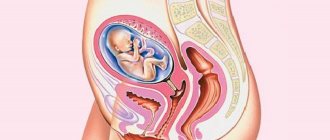Scientific approach
There are many theories about the birth of girls and boys. The official version suggests understanding the X and Y chromosomes and paying attention to the moment of ovulation. In order for a boy to be born, the released egg must meet a sperm with a Y chromosome.
There is no such chromosome in a woman’s body, so it is believed that the sex of the unborn child depends entirely on the man.
Sperm with a Y chromosome are very fast and lighter than their X counterparts. They only live for two days, so if parents want a boy, then they need to try to conceive the day before, the day after and on the day of ovulation. While sperm with an X chromosome, on which the birth of girls depends, are more resilient, are able to live in a woman’s body for up to five days and can wait for the release of the egg or even fertilize it later.
Science also suggests that a woman’s orgasm prior to conception increases the chances of having a boy: at this moment, the vaginal environment changes to an alkaline one, which helps the sperm with the Y chromosome responsible for the birth of a boy to move faster towards the egg.
Despite the fact that science is revealing many secrets of the universe, unfortunately, it cannot yet reliably answer the question of what gender a child will be born to this particular woman. To find the answer to this question, you can resort to experience, centuries-old observations and various kinds of hypotheses, which are sometimes confirmed by science.
How to set your expected due date
There are several ways to help calculate the length of pregnancy.
The obstetric method (based on the date of the last menstruation) is the most common.
The main figure from which the countdown is based is the date of the start of the last menstruation. To do this, the Naegele formula is used, according to which nine full months and one week are added to the date of the last menstruation.
Important! An even simpler calculation can be made if you subtract three full months from the start date of your last period and also add one week.
Expert commentary
– This is how the pregnancy period is calculated, but not conception, since at the time of the onset of menstruation, pregnancy has not yet occurred. This means that with a 40-week calendar, actual conception occurs only in the third week (after all, ovulation on average can occur on the fourteenth to fifteenth day after the end of menstruation), and therefore the gestational age of the child will be approximately two to three weeks less.
When calculating the obstetric gestational age, only the average duration of the menstrual cycle with ovulation in the middle (on the fourteenth to fifteenth day) is usually taken into account. If you have irregular periods, disruptions in your cycle, it lasts more or less than twenty-eight days, you will have to take all these nuances into account. For example, if your cycle is longer, then add the required number of days to the proposed calculation, and if less, subtract.
Embryonic method (by date of ovulation and conception).
This method of calculating the date of birth and determining the duration of pregnancy can be used if you know exactly not only the day and time of conception, but also the day and time of maturation of the egg.
The day of conception (known or suspected) corresponds to 2 full obstetric weeks of pregnancy, i.e. on the first morning after successful intercourse, the gestational age is. 2 weeks and 7 hours! The duration of pregnancy from this date will be about two hundred and sixty-six days or thirty-eight weeks. But this method is almost never used, because few expectant mothers will be able to provide the doctor with such accurate information.
Ultrasonography
The most effective method for determining the gestational age (the so-called period from fertilization of an egg by a sperm to the birth of a child) is an ultrasound examination in the first trimester (measuring the diameter of the gestational sac up to 6 weeks, and then measuring the coccygeal-parietal size of the fetus (CPR) up to 14 weeks).
Expert commentary
– Routine ultrasound in the first and second trimesters of pregnancy has made it possible to significantly reduce the frequency of previously recorded post-term pregnancy. It is important to remember that the earlier the ultrasound is performed, the more accurately the gestational age can be determined. Measuring the CTE of an embryo in the first trimester makes it possible to obtain the most accurate gestational age with an error of ± 3-5 days.
Determining the period by KTP after 12 weeks becomes less accurate. And errors in determining the due date according to ultrasound data in the third trimester already increase to 3–4 weeks!
A bimanual examination at the first visit to the antenatal clinic in the first trimester, unfortunately, does not allow one to accurately determine the duration of pregnancy - the error is 2-3 weeks.
Other methods for determining the duration of pregnancy include:
- date of first positive pregnancy test (β-hCG),
- the date of the first listening to heart sounds (at 12 weeks using a Doppler sensor and from 18 weeks - with a stethoscope),
- date the fundus of the uterus reaches the level of the navel (20 weeks)
- the date of the first fetal movement felt by the mother.
Important! It is believed that if a woman is carrying her first child, then 20 weeks must be added to the date when she felt his first movement, and if this is not the first pregnancy, then 22 weeks. However, these numbers are very relative, since few women are able to immediately recognize the baby’s movements, often confusing them with intestinal peristalsis.
Nordic character
People have long noticed that women with a strong and energetic character are more likely to give birth to boys. This can be explained with the help of scientific knowledge: since at the moment of conception and for some time after it, each fetus demonstrates the presence of female genital organs, since it is affected by the mother’s hormones, in particular estrogen.
The picture begins to change under the influence of testosterone: the more testosterone the mother has, the greater the likelihood of having a boy. Popular rumor also confirms this theory by the fact that men like independent women more, so they are loved more, and they are more likely to have boys. If a woman is not confident in herself and clearly demonstrates behavior more dependent on the man in a relationship, then she will most likely have a daughter.
© Getty Images/EyeEm
Who is better - a boy or a girl and why there are not enough women on the planet
“The phenomena described by The Telegraph have existed for a long time,” says Igor Beloborodov, director of the Institute of Demographic Research.
In China, 100 girls are born for every 120 boys; in India, the ratio is 112 to 100. This is largely the result of selective abortions: unwanted girls are “weeded out” after ultrasound examinations, Beloborodov explains. “The preference given to boys under the one-child policy in China is a feature of patriarchal cultures,” explains Igor Beloborodov.
As a result, “in China, 40 million men of working age no longer have wives, and this is a huge number,” the demographer emphasizes.
In India, he said, over the past 20 years, 20 million girls have been aborted. The phenomenon of gendercide, by analogy with genocide, has emerged - murder based on gender. In some areas of India, says Igor Beloborodov, there is even “infanticide—the killing of newborn girls.”
As a result, polygamy appears in India in the form of polyandry, when a woman lives with her husband and at the same time cohabits with his single brothers, the expert says. Another option is when young girls are simply kidnapped for marriage.
“Men can go to other countries in search of brides,” adds Alexey Komov, head of the representative office in Russia and the CIS of the World Congress of Families (WCF), Ambassador of the WCF to the UN. “The immigration of Chinese to Russia - Siberia and the Far East - is partly dictated by the search for a mate,” says Vera Abramenkova, head of the laboratory at the Institute of Psychological and Pedagogical Problems of Childhood of the Russian Academy of Education, professor at the Moscow State University of Psychology and Education.
The consequences of gender imbalance in psychology are obvious. “The standards of male and female behavior are being destroyed faster,” says Vera Abramenkova.
“There is a feminization of the masculine and a masculinization of the feminine. The lines between the sexes are blurring, women increasingly prefer the male image, and for men, on the contrary, it is increasingly difficult to maintain masculinity, social and psychological maturity in the current conditions,” says the psychologist. This phenomenon is observed in many countries, including Russia.
There are always more boys born: hypotheses and reality
“Teachers in Russian kindergartens and schools have noted the predominance of boys over girls over the past 2-3 years,” says Marina Egorova, dean of the faculty of educational psychology at the Moscow City Psychological and Pedagogical University. “When we do gender studies in schools, we often have to pick up girls; there are always more boys,” says the expert.
As of January 1 last year, there were 899 thousand boys under one year old in Russia and 851 thousand girls of the same age, Rosstat provides data.
“We do not notice any fundamental changes in the ratio of boys and girls,” notes Sergei Zakharov, deputy director of the Institute of Demography at the National Research University Higher School of Economics. There are always more boys born than girls, he emphasizes. The ratio is approximately 105-106 to 100. The proportion of newborn boys and girls “remains at this level in Russia.”
Regarding the natural imbalance of newborn boys and girls, there is a famous hypothesis of biologist, chemist and physicist Vigen Geodakyan, author of the work “Evolutionary Theory of Sex,” says Vera Abramenkova, head of the laboratory of the Institute of Psychological and Pedagogical Problems of Childhood of the Russian Academy of Education. RIA Novosti's interlocutor interprets the essence of this hypothesis as follows: “Men are the compass of evolution and variability.”
Geodakyan’s eternal imbalance of boys and girls is explained by the fact that “men in the evolutionary process are responsible for variability, and women are responsible for constancy,” Sergei Zakharov explains the theory. More boys are born “because they have to move around to find the best [survival] strategies,” he explains.
The thing to worry about is not the imbalance between boys and girls, but the “huge gap between male and female mortality and early orphanhood,” the demographer says. Men in Russia die earlier. The All-Russian Population Census recorded the fact: there are 10.5 million more women (there are almost 143 million Russians in total).
“Men expend more energy to survive and engage in more risky behavior,” says the demographer.
Risky behavior includes alcoholism, drug addiction, road accidents, and various types of injuries.
In Russia, “both boys and girls are valued”
For Russia, unlike Georgia or Armenia, “gender preference [for children]” is not yet typical, says Sergei Zakharov.
Selective abortions have already appeared in Georgia, Armenia and Azerbaijan, notes Igor Beloborodov. For every 120 boys, 100 girls are born, says the demographer.
“In Russia, in conditions of widespread small families - a family orientation towards the birth of one baby, the gender of the child often does not matter much,” says Igor Beloborodov. “One of the motives for having a second child is preference for a boy or a girl.”
“In Russia, men often wanted a daughter to be born,” says Vera Abramenkova.
“We tried to have a girl four times,” says my friend, Elena Smirnova, mother of four boys. “But when we found out that a boy would be born, we didn’t even think about abortion.”
“We first had a son, but we also wanted a girl,” says Natalya Portnova, mother of two boys and two girls. - The second son was born. We decided to try again with a girl.” Natalya's third daughter was born. Then the family decided “to have another daughter for good measure,” notes RIA’s interlocutor.
In general, both boys and girls are “rated” in Russia, but in certain regions, for example, in the North Caucasus - in Dagestan, Ingushetia, Kabardino-Balkaria - selective abortions are gradually appearing, says Igor Beloborodov. “The birth rate is still high in the villages, but in the cities such family planning technologies are already spreading, when after an ultrasound, if the parents are not satisfied with the sex of the child, they have an abortion,” says the agency’s interlocutor.
“The dropout of girls as a phenomenon is one way or another passing to Europe,” concludes Igor Beloborodov.
In Europe, there is a serious debate about whether to ban gender determination using ultrasound,” adds Alexey Komov. — There are often cases when the sex of the child is not the one needed. And sometimes there are mistakes when determining gender using ultrasound.”
Having few children and childlessness is worse
With all the gender changes, there is an even more alarming trend - a reluctance to have children at all, says Igor Beloborodov, director of the Institute of Demographic Research. “Mass childlessness is observed in different parts of the world: in Germany, Shanghai, Hong Kong.” In Europe, for example, 20 percent of young women are childless. Some of them are convinced child-free, opponents of childbearing, some are simply typical representatives of “consumer society who are carried away by their careers,” and some are with unconventional orientation, says the demographer.
“Judging by the facts, child-free does not have a significant effect on the birth rate,” says Sergei Zakharov, deputy director of the Institute of Demography at the National Research University Higher School of Economics. “A more important objective for [Russian] government policy is for the birth rate to rise from the current 1.6 to at least 2.1.”
Such a ratio would mean that the average woman under the age of 50 would have more than two births. This ensures the so-called natural reproduction of the population - maintaining its numbers.
“There are no catastrophic changes in the birth rate,” notes the deputy director of the HSE Institute of Demography. The decline in the birth rate since the middle of the century has not been very significant: in the 1940s-1950s this rate was 1.8, in the 1980s it settled at 1.6 and has remained approximately the same, emphasizes Sergei Zakharov.
40% of women have two births, says the deputy director of the HSE Institute of Demography. A recent survey conducted this year by the Institute of Demography - “Parents and children, men and women in the family and society” - showed that many families are focused on having two children, the expert notes.
It is necessary to work with the reproductive stereotypes of young people - with ideas about the family and the number of children in it, says Alexey Komov. Now the main educator of the average European teenager is the media, including television and Internet publications, the expert says. And in the media, the assessment of the family is often negative.
The state encourages “those people who grew up with few children” to have two or more children, says Sergei Zakharov. “They have already accepted that motivation. Already in adolescence, a person has ideas about what a family should be like,” he explains.
It is difficult to change reproductive stereotypes “if it was the result of long-term historical changes,” emphasizes Sergei Zakharov.
“Material and financial assistance, agitation, creating a friendly attitude in society towards families with two children - this whole set of measures can increase the birth rate by 0.1 - 0.2. And this is already significant,” concludes the RIA Novosti interlocutor.
The author's opinion may not coincide with the position of the editors
Restore balance
From an energetic point of view, the appearance of a boy is due to the presence of a reserve of unspent warmth and tenderness in the expectant mother, which she urgently needs to transfer to her baby. If a woman has an energy deficit, she experiences a lack of tenderness, then she will most likely give birth to a girl in order to restore the lost balance and give her mother a little warmth, which she clearly lacked.
In fact, nature very intelligently distributes girls and boys so that each mother gets what she needs. In families where boys are born, women are surrounded by great attention from their husbands. While women who give birth to girls experience some problems in their relationship with their husband, so they need some balancing of the feminine energy in their home.
Why is walking dangerous?
Post-term pregnancy can have catastrophic consequences for both mother and baby.
Among post-term pregnancies, a large percentage of births are by cesarean section, and the surgical intervention itself threatens a large number of complications.
For mother
A post-term fetus is almost always large in size, which can lead to damage to the birth canal, rupture of the perineum, cervix and vaginal walls. These injuries can subsequently lead to serious problems - incontinence or urinary retention, prolapse of the vagina and uterus, and the formation of fistulas. When performing a cesarean section, there is a risk of bleeding, postpartum infections, and thromboembolism.
For the fetus
Postmaturity increases the likelihood of increased sensitivity to a lack of oxygen, since the degree of maturity of the brain is already high; if the placenta cannot cope with providing the baby with oxygen, then he develops hypoxia.
In post-term babies, the bones of the skull become dense, which makes it difficult for the head to pass through the birth canal, which greatly increases the likelihood of birth injuries.
Complications during post-term pregnancy
If you make the independent decision to stay home beyond 41 weeks, remember: you are taking a huge risk. Post-term pregnancy is a serious complication for both the fetus and the mother.
Aging of the placenta
The tissue of the placenta at this stage is already changing, placental insufficiency develops, leading to hypoxia (oxygen starvation) of the fetus, and due to the greater maturity of the central nervous system, post-term babies have increased sensitivity to hypoxia. Violation of the permeability and protective function of the placenta is often accompanied by intrauterine infection.
Child parameters
Large head sizes, dense skull bones, narrow sutures and fontanelles increase the likelihood of birth trauma.
Respiratory diseases
Frequent complications in post-term infants are the syndrome of respiratory distress and pneumopathy (for example, intrauterine aspiration of amniotic fluid).
Subsequent developmental delay
With postmaturity, the risk of perinatal mortality increases significantly (1.5 - 2 times), largely due to intrapartum (intrauterine) fetal death. However, if the baby is born alive and healthy, he still runs the risk of significantly falling behind in physical and neuropsychic development in the future.
Expert commentary
– Perhaps the most unpleasant complication is the worsening of placental insufficiency. The fact is that the placenta is a temporary organ, designed to exist in the body for 40-42 weeks. Accordingly, by the 41st week the placenta begins to deplete, dystrophic changes occur in it, which is why the baby may experience a lack of oxygen. And the most formidable complication, no matter how much I would like to keep silent about it, is antenatal fetal death, the risk of which increases from the 42nd week. To avoid troubles, constant monitoring of cardiotocography and Doppler monitoring of the fetus and, of course, monitoring the health of the expectant mother herself is necessary.









